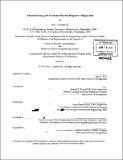Allocation strategy for production network designed to mitigate risk
Author(s)
Lehman, Roy J., III (Roy Jacob)
DownloadFull printable version (10.09Mb)
Alternative title
Efficient product allocation strategy to enable network-wide risk mitigation
Other Contributors
Leaders for Global Operations Program.
Advisor
Donald B. Rosenfield and David Simchi-Levi.
Terms of use
Metadata
Show full item recordAbstract
Amgen Inc. currently manufactures, formulates and fills substantially all of their global drug product units in a single primary facility ("Site 1A"). Concerned about the inherent risks posed by the geographic concentration of these activities, Amgen has decided to acquire a new international Risk Mitigation Site ("RMS"), expand existing bulk manufacturing infrastructure at Site 1A, and construct a new formulation and filling facility colocated with Site 1A ("Site IB"). Bringing both sites online in the near future will create a novel operational challenge for Amgen, as it will present a broad range of formulation/fill production allocation decisions that did not previously exist. If per-unit costs (production, logistics, etc.) were considered to be typically higher at either RMS or Site 1A/B, an unconstrained optimization model might suggest filling/finishing all product at whichever site has the lowest average cost. However, we assume that RMS should be able to ramp up to full capacity within 3 months of an adverse occurrence at Site 1A. This translates to a minimum product flow constraint through RMS, irrespective of per unit costs, that will keep the facility sufficiently staffed to prepare for a fast ramp-up. Furthermore, helping Amgen mitigate the risks of geographic concentration, RMS may typically produce only a portion of global demand for any product. Given this situation, this thesis develops a product allocation strategy that will: 1) minimize the financial cost of filling various quantities of drug product at the new facility, yet 2) maintain at RMS the expertise required begin manufacturing all drugs in a short period of time. A mixed-integer linear program ("MILP") was developed to capture variable costs of the formulation & fill process for each drug product ("DP") and market combination. The objective of this model is to minimize total supply chain costs subject to meeting market demand and maintaining a sufficient amount of product flow through the RMS facility. The analysis assumes that the decision to develop fill capacity at both RMS and Site lB is complete and that both facilities will be licensed to fill all products that currently run through Site 1A (i.e. capital investment decisions will not be analyzed in this study). The outcome of this study is a product allocation strategy that minimizes network costs as well as a tool that will enable Amgen to solve for minimal network costs under additional future scenarios.
Description
Thesis (M.B.A.)--Massachusetts Institute of Technology, Sloan School of Management; and, (S.M.)--Massachusetts Institute of Technology, Engineering Systems Division; in conjunction with the Leaders for Global Operations Program at MIT, 2011. Cataloged from PDF version of thesis. Includes bibliographical references (p. 65-66).
Date issued
2011Department
Leaders for Global Operations Program at MIT; Massachusetts Institute of Technology. Engineering Systems Division; Sloan School of ManagementPublisher
Massachusetts Institute of Technology
Keywords
Sloan School of Management., Engineering Systems Division., Leaders for Global Operations Program.